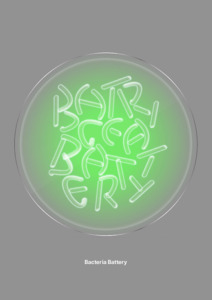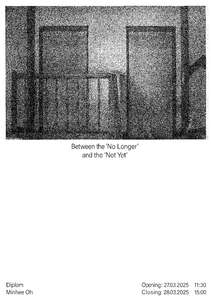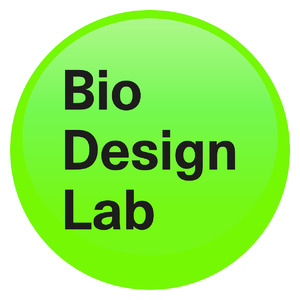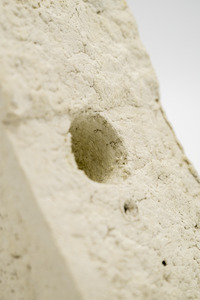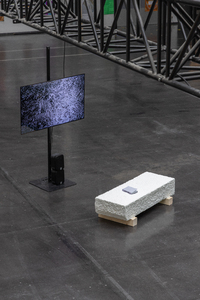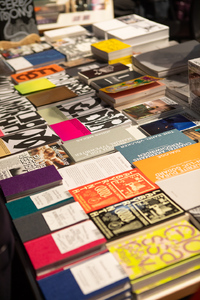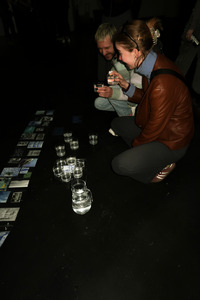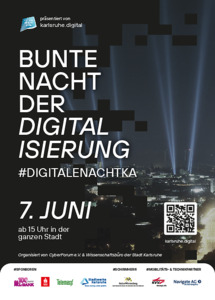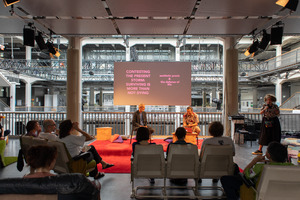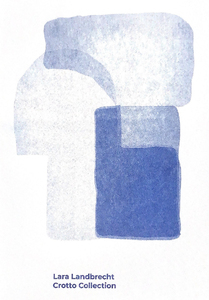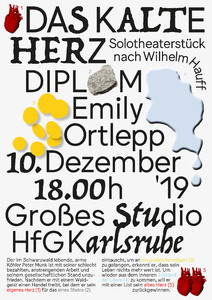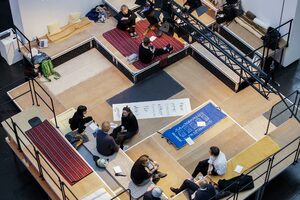"Staatliche Hochschule für Gestaltung (HfG) Karlsruhe"
| Begriff | Staatliche Hochschule für Gestaltung (HfG) Karlsruhe |
| Metakey | Ort: Institution (creative_work:location_institution) |
| Typ | Keyword |
| Vokabular | Werk |
92 Inhalte
Filter werden geladen
- Seite 1 von 8
Bacteria Battery
- Titel
- Bacteria Battery
- Titel (en)
- Bacteria Battery
- Beschreibung (de)
- Die Poesie grüner Energie – Auf der Suche nach regenerativer Stromerzeugung gehen wir für einen Tag eine spannende Verflechtung mit winzigen Mikro-Organismen ein. So zeigen uns die Bio Artists und Forscher Rasa Smite und Raitis Smits / RIXC in ihrem Hands-On Workshop, wie mit Hilfe von Elektroden und Schlamm sogenannte „Bakterien Batterien“ hergestellt werden können. Dabei bekommen wir nicht nur einen Einblick in die faszinierende Technologie Mikrobieller Brennstoffzellen, sondern auch in die unterschiedlichen Forschungsstände, die Studierende der HfG Karlsruhe hierzu in einem vorangegangenen, gleichnamigen Seminar während des letzten Semesters erarbeitet haben. Mit diesem theoretischen Input geht es anschließend an die eigene künstlerische useinandersetzung: In einer Schritt-für-Schritt-Anleitung stellen wir so mittels eines bereitgestellten DIY-KITS unsere eigenen Bakterien-Batterien her.
- Beschreibung (en)
- The poetics of green energy – In the search for regenerative power generation, we enter into an exciting entanglement with tiny micro-organisms for one day. In their hands-on workshop, bio-artists and researchers Rasa Smite and Raitis Smits / RIXC will show us how so-called "bacteria batteries" can be produced with the help of electrodes and mud. We will not only get an insight into the fascinating technology of microbial fuel cells, but also into the different research results that students of the HfG Karlsruhe have developed in a related previous seminar during the last semester. With this theoretical input, we will then get down to our own artistic exploration: in step-by-step instructions, we will make our own bacteria batteries using a provided DIY Kit.
- Typ des Projekts/Werks
- Schlagworte
- Datierung
- 29.01.2021
- Mitwirkende
- Material
- Ort: Institution
- Ort
- Bio Design Lab
- Stadt
- Land
- Internetlinks
- Titel
- Bacteria Battery
- Projektleiter/in
- Semester
- Importiert am
- 25.10.2023
- Übergeordnete Sets
- 1
- Set enthält
- 0 10
Between the 'No Longer' and the 'Not Yet'
- Titel
- Between the 'No Longer' and the 'Not Yet'
- Autor/in
- Beschreibung (de)
- Der Titel dieser Ausstellung, "Between the 'No Longer' and the 'Not Yet'", stammt aus den Schriften von Victor Turner über Liminalität. Turner beschreibt Liminalität als einen Übergangszustand – einen Moment, in dem man eine frühere Rolle oder einen früheren Status verlassen hat aber noch nicht vollständig in eine neue Position eingetreten ist. Es ist ein Zustand der Ungewissheit und Transformation. Vertraute Strukturen lösen sich auf und lassen einen in einer undefinierten und instabilen Lage zurück.
Dieses Konzept spiegelt meine Erfahrung als Ausländerin in Deutschland wider. Ich habe Korea verlassen, befinde mich aber noch immer in einem Schwebezustand, ohne mich vollständig angekommen zu fühlen. Um diesen Zustand des Dazwischen auszudrücken, habe ich Flure als visuelle Metapher verwendet. Beim leisen Umherwandern durch diese Flure, beim Fotografieren aus der Distanz, bin ich mir selbst begegnet.
Aus dem fotografischen Projekt entwickelte sich die Videoarbeit "The Act of Cleaning" (2025), die gemeinsam mit den Fotografien gezeigt wird. Inspiriert von Mary Douglas' Ideen zu Reinigungsritualen – bei denen das Säubern Ordnung in das Chaos bringt –, habe ich das Putzen zu meinem eigenen Ritual gemacht. Douglas argumentiert, dass Gesellschaften Ordnung schaffen, indem sie Dinge in klare Kategorien einteilen. Doch Wesen oder Konzepte, die sich diesen Kategorien entziehen – wie Migrant*innen, Hybride oder diejenigen in Übergangszuständen –, werden oft als störend empfunden. In diesem Kontext wurde das Reinigen zu einem Weg, mit der Spannung des Dazwischenseins umzugehen.
Mit bloßen Händen wischte ich jede Stufe der Treppen ab, durch die ich mich bewegte. Die Reibung zwischen Lappen und Boden, das Geräusch des ausgewrungenen Wassers und das Echo meiner Schritte füllten den Flur. Der Boden wurde vollkommen durchnässt – die Grenze zwischen Reinigen und Verschmutzen verschwamm. Diese repetitive, beinahe meditative Handlung veränderte meine Beziehung zu diesen Räumen. Das Putzen wurde mehr als eine praktische Geste – es wurde zu einem Akt, meine Präsenz zu behaupten und sie zugleich zu hinterfragen.
Wie kann ich hier existieren?
- Der Titel dieser Ausstellung, "Between the 'No Longer' and the 'Not Yet'", stammt aus den Schriften von Victor Turner über Liminalität. Turner beschreibt Liminalität als einen Übergangszustand – einen Moment, in dem man eine frühere Rolle oder einen früheren Status verlassen hat aber noch nicht vollständig in eine neue Position eingetreten ist. Es ist ein Zustand der Ungewissheit und Transformation. Vertraute Strukturen lösen sich auf und lassen einen in einer undefinierten und instabilen Lage zurück.
- Beschreibung (en)
- The title of this exhibition, "Between the 'No Longer' and the 'Not Yet'", comes from Victor Turner's writings on liminality. Turner describes liminality as a transitional state—when one has left behind a previous role or status but has not yet fully entered a new one. It is a state of ambiguity and transformation. Familiar structures dissolve, leaving one in an undefined and unstable position.
This concept reflects my experience as a foreigner in Germany. I left Korea, yet I find myself lingering in a liminal state, not fully settled. To convey this in-between state, I used hallways as a visual metaphor. Wandering through hallways quietly, photographing them from a distance, I came face to face with myself.
This photographic project developed into the video work, "The Act of Cleaning" (2025), which is presented alongside the photographs. Inspired by Mary Douglas's ideas on purification rituals—where cleaning imposes order on chaos—I chose cleaning as my own ritual. Douglas argues that societies create order by classifying things into clear categories. Yet, beings or concepts that defy these categories—such as migrants, hybrids, or those in transitional states—are often seen as unsettling. In this context, cleaning became a way to navigate the tension of existing in ambiguity.
Using my bare hands, I wiped down each step of the staircases I walked through. The friction between the rag and the floor, the sound of squeezing water, and the echo of my footsteps filled the hallway. The floor became completely soaked, blurring the boundary between cleaning and staining. This repetitive, almost meditative act transformed my relationship with these spaces. Cleaning became more than a practical gesture—it was a way to assert my presence while simultaneously questioning it.
In what ways can I exist here?
- The title of this exhibition, "Between the 'No Longer' and the 'Not Yet'", comes from Victor Turner's writings on liminality. Turner describes liminality as a transitional state—when one has left behind a previous role or status but has not yet fully entered a new one. It is a state of ambiguity and transformation. Familiar structures dissolve, leaving one in an undefined and unstable position.
- Kategorie
- Typ des Projekts/Werks
- Schlagworte
- Datierung
- 29.05.2025
- Mitwirkende
- Dank an
- Ort: Institution
- Ort
- Lichthof
- Stadt
- Land
- Titel
- Between the 'No Longer' and the 'Not Yet'
- Projektleiter/in
- Semester
- Studiengang
- Typ der Abschlussarbeit
- Importiert am
- 29.05.2025
- Übergeordnete Sets
- 1
- Set enthält
- 0 9
Bio Design Lab
- Titel
- Bio Design Lab
- Beschreibung (de)
- Das Bio Design Lab ist ein hybrider und evolutiver Ort, der sowohl im digitalen als auch im physischen Raum existiert. Konzipiert als wachsende Plattform, die die Fachbereiche der Staatlichen Hochschule für Gestaltung miteinander verbindet, wird das Labor als Raum für Präsentation, Bildung und Wissensvermittlung genutzt.
Das Bio Design Lab konzentriert sich auf die lokale Region, ihre Ressourcen und Möglichkeiten und zielt aktiv darauf ab, die Produktionsweisen in Karlsruhe und Süddeutschland umzugestalten und neu zu überdenken. Zur Interaktion mit diesen Themen und Materialien, sowohl im digitalen als auch im physischen Raum, lädt das Labor lokale ExpertInnen und BesucherInnen gleichermaßen ein an gemeinsamen Projekten zu arbeiten.
Spuren dieser Aktivitäten komplementieren ein ständig wachsenden Netzwerk.Das Wissen über diese Ressourcen wird durch die Erstellung eines Know-how-Glossars und einer Materialbibliothek destilliert, durch virtuelle und physische Workshops vermittelt, sowie durch die Präsentationen herausragender Projekte, die sich mit nachhaltigen Materialien befassen, kommuniziert.
Das Labor fungiert als Inkubator und Modell für Zusammenarbeit und Produktion, das im Einklang mit dem aktuellen Wandel der Staatlichen Hochschule für Gestaltung Karlsruhe steht.
- Das Bio Design Lab ist ein hybrider und evolutiver Ort, der sowohl im digitalen als auch im physischen Raum existiert. Konzipiert als wachsende Plattform, die die Fachbereiche der Staatlichen Hochschule für Gestaltung miteinander verbindet, wird das Labor als Raum für Präsentation, Bildung und Wissensvermittlung genutzt.
- Beschreibung (en)
- The Bio Design Lab is a hybrid and evolutive environment that exists in both the digital and physical space. Conceived as a platform for connection and collaboration with local partners and using local resources, the Lab hosts the presentation, education and transmission of knowledge. As students and experts are invited to work on bio-design related projects, visitors can explore and interact with the Lab’s production and lines of inquiry.
Projects within the Lab focus on the local region, its materials and possibilities, and actively aim to reshuffle and rethink modes of production in Karlsruhe and the south of Germany. Topics under exploration include Algae, Soil, Plants, Body, and Agriculture. To interact with these themes and related materials, both within the digital and physical space, the Lab invites local experts and visitors alike.
Within the Bio Design Lab, regional resources are collected by connecting with local partners; they are then distilled through the making of a know-how glossary and a material library, aiming to develop local materials. The knowledge around these resources is disseminated through virtual workshops and multimedia presentations of outstanding projects dealing with sustainable materials. Ultimately, traces of these activities will remain in a constantly growing network, both in the digital platform and in physical displays of existing and future objects.
The Lab works as an incubator and a model for collaboration and production that is in line with the current transformation of the Karlsruhe University of the Arts and Design Karlsruhe. It was first presented to the public in the context of Critical Zones, an exhibition at ZKM | Center for Art and Media.
- The Bio Design Lab is a hybrid and evolutive environment that exists in both the digital and physical space. Conceived as a platform for connection and collaboration with local partners and using local resources, the Lab hosts the presentation, education and transmission of knowledge. As students and experts are invited to work on bio-design related projects, visitors can explore and interact with the Lab’s production and lines of inquiry.
- Schlagworte
- Ort: Institution
- Ort
- Bio Design Lab
- Stadt
- Land
- Internetlinks
- Titel
- Bio Design Lab
- Projektleiter/in
- Importiert am
- 23.10.2023
- Übergeordnete Sets
- 0
- Set enthält
- 5 2
Biosensorium
- Titel
- Biosensorium
- Titel (en)
- Biosensorium
- Beschreibung (de)
- Wie können wir einen organischen Erfahrungsraum herstellen, der uns auf sinnlicher Ebene berührt? Und was genau bedeutet es, mit nicht-menschlichen Akteuren in einen kollaborativen Gestaltungsprozess zu treten? Im „Bio-Sensorium“ kommen verschiedene lebendige Werkstoffe zu einem raumgreifenden Experiment zusammen. Gemeinsam mit Studierenden wurde so im Bio Design Lab für das Wissenschaftsfestival „Effekte“ (12.–20.06.2021) ein temporärer Pavillon aus
alternativen Baustoffen entwickelt, der ein mögliches Szenario auf materieller wie gestalterischer Ebene erlebbar werden lässt. Eine selbstgefertigte Struktur aus Papercrete (Spezialbeton aus Recyclingpapier) dient dabei auf dem HfG Open Campus als multifunktionales, wachsendes Display-System, in dem weitere biobasierte Materialexperimente ihren Platz finden. Ob Mycelium-Komposit (Baustoff aus Pilzgeflecht), Bioplastik oder Kombucha-Leder – die Samples erlauben mit ihren unterschiedlichen Formen, Haptiken und Gerüchen vielseitige Perspektiven auf biobasierte Werkstoffe im Design-Kontext und geben zugleich Anstoß zum Umdenken bisheriger Produktions-und Konsumprozesse.
Zudem ergänzte der Hands-On Workshop “Ein Haus aus Papier?” die analoge Inszenierung auf dem HfG Gelände im digitalen Raum. So wurden am Sonntag, den 13.06.2021 von 13.00–17.00 Uhr, Material-Hintergründe wie auch die Herstellungsmethode von Papercrete Schritt für Schritt in einem Streaming-Format vermittelt. Ein speziell gefertigtes Home-Kit-Paket mit weiteren Informationen und Materialien wurde den Teilnehmer geschickt, sodass ein gemeinsames Gestalten (über-)regional mit und trotz Abstand möglich war.
Ein Bühnentalk auf dem Kronenplatz (14.06.2021, 20.00 Uhr), bei dem die Macher und Studierenden Einblicke in die Hintergründe des Projekts gaben, vervollständigte das Programm.
Das Bio-Sensorium war im Anschluss an das Effekte Festival der Stadt Karlsruhe im Rahmen der deutsch-französischen Wanderausstellung „Frugalité Créative (03.07–07.08.2021) noch bis Anfang August als Außen-Exponat zu sehen.
- Wie können wir einen organischen Erfahrungsraum herstellen, der uns auf sinnlicher Ebene berührt? Und was genau bedeutet es, mit nicht-menschlichen Akteuren in einen kollaborativen Gestaltungsprozess zu treten? Im „Bio-Sensorium“ kommen verschiedene lebendige Werkstoffe zu einem raumgreifenden Experiment zusammen. Gemeinsam mit Studierenden wurde so im Bio Design Lab für das Wissenschaftsfestival „Effekte“ (12.–20.06.2021) ein temporärer Pavillon aus
- Beschreibung (en)
- How can we create an organic experiential space that touches us on a sensory level? And what exactly does it mean to enter into a collaborative design process with non-human actors? In the "Bio-Sensorium", various living materials come together in a space-filling experiment. Together with students, a temporary pavilion was developed in the Bio Design Lab for the "Effekte" science festival (June 12-20, 2021) using alternative building materials, which allows us to expierience a possible scenario on a material and design level. In this context, a self-made structure of Papercrete (special concrete made of recycled paper) serves as a multifunctional, growing display system on the HfG Open Campus, in which further bio-based material experiments find their place. Whether mycelium composite (building material made of mushroom mesh), bioplastics or kombucha leather - with their different shapes, haptics and smells, the samples allow versatile perspectives on bio-based materials in the design context and at the same time provide impulses for rethinking previous production and consumption processes.
In addition, the hands-on workshop "A house made of paper?" complemented the analog staging on the HfG grounds in the digital space. Thus, on Sunday, June 13, 2021 from 13:00-17:00, material backgrounds as well as the manufacturing method of Papercrete were taught step by step in a streaming format. A specially made Home-Kit with further information and materials was sent to the participants, so that a joint design (over-)regionally with and despite distance was possible.
A stage talk on the Kronenplatz (14.06.2021, 20.00), where the makers and students gave insights into the background of the project, completed the program.
The Bio-Sensorium was on display as an outdoor exhibit following the Effekte Festival of the City of Karlsruhe as part of the German-French traveling exhibition "Frugalité Créative (03.07-07.08.2021) until the beginning of August.
- How can we create an organic experiential space that touches us on a sensory level? And what exactly does it mean to enter into a collaborative design process with non-human actors? In the "Bio-Sensorium", various living materials come together in a space-filling experiment. Together with students, a temporary pavilion was developed in the Bio Design Lab for the "Effekte" science festival (June 12-20, 2021) using alternative building materials, which allows us to expierience a possible scenario on a material and design level. In this context, a self-made structure of Papercrete (special concrete made of recycled paper) serves as a multifunctional, growing display system on the HfG Open Campus, in which further bio-based material experiments find their place. Whether mycelium composite (building material made of mushroom mesh), bioplastics or kombucha leather - with their different shapes, haptics and smells, the samples allow versatile perspectives on bio-based materials in the design context and at the same time provide impulses for rethinking previous production and consumption processes.
- Typ des Projekts/Werks
- Schlagworte
- Mitwirkende
- Material
- Ort: Institution
- Ort
- HfG Open Campus
- Stadt
- Land
- Beteiligte Institution(en)
- Titel
- Biosensorium
- Projektleiter/in
- Semester
- Lehrveranstaltung
- Importiert am
- 26.10.2023
- Übergeordnete Sets
- 1
- Set enthält
- 0 43
block to blob
- Titel
- block to blob
- Titel (en)
- block to blob
- Untertitel
- tracing back materiality
- Untertitel des Projekts/Werks (en)
- tracing back materiality
- Autor/in
- Beschreibung (de)
- Dieses Diplomprojekt dokumentiert den Materialstrom von synthetischen Kunststoffen durch einen rückwärtsgerichteten chronologischen Ansatz. Es kombiniert Feldforschung, visuelle Dokumentation und Materialexperimente, um die Reise von Kunststoffen von ihren Endprodukten zurück zu ihrem Ursprung im Erdöl nachzuvollziehen.
"Block to Blob" umfasst Besuche an verschiedenen Orten der Produktionskette, wie etwa Produktionsanlagen, Ölraffinerien, Pipelines und Förderstätten und endet in einem Waldökosystem, wo Rohöl auf natürliche Weise an die Erdoberfläche tritt. Diese Erfahrungen werden in einer Forschungspublikation zusammengestellt, die dieser rückwärtsgerichteten Erzählweise folgt.
Eine Videoinstallation dokumentiert die besuchten Orte und liefert einen visuellen Kontext zu den industriellen Prozessen, der verborgenen Infrastruktur und der natürlichen Substanz im Wald. Zusätzlich verankert eine Reihe von Objekten, die aus mit Erdöl beschichtetem Holz und Polystyrol gefertigt sind, das Projekt in greifbaren Materialien.
- Dieses Diplomprojekt dokumentiert den Materialstrom von synthetischen Kunststoffen durch einen rückwärtsgerichteten chronologischen Ansatz. Es kombiniert Feldforschung, visuelle Dokumentation und Materialexperimente, um die Reise von Kunststoffen von ihren Endprodukten zurück zu ihrem Ursprung im Erdöl nachzuvollziehen.
- Beschreibung (en)
- This diploma project details the material stream of synthetic plastics through a reverse chronological approach. It combines field research, visual documentation, and material experimentation to retrace the journey of plastics from their final products back to their origins in petroleum.
‘block to blob’ includes visits to various sites in the production chain, such as manufacturing facilities, oil refineries, pipelines, and extraction sites, concluding in a forest ecosystem, where crude oil naturally seeps to the earth's surface. These experiences are compiled into a research publication that follows this reverse narrative.
A video installation documents the visited locations, providing visual context for the industrial processes, hidden infrastructure and the natural substance in the forest. Additionally, a series of objects made from petroleum-coated wood and polystyrene grounds the project in tangible materials.
- This diploma project details the material stream of synthetic plastics through a reverse chronological approach. It combines field research, visual documentation, and material experimentation to retrace the journey of plastics from their final products back to their origins in petroleum.
- Kategorie
- Typ des Projekts/Werks
- Schlagworte
- Datierung
- 2024
- Sprache
- Untertitel (Film)
- Material
- Technik/Verfahren/Formate
- Pine wood coated with petroleum, Wood soaked in gasoline and pressed/bonded with polystyrene
- Abmessungen
- L x B x H mm, Petroleum-coated wooden objects: Bench: 800 x 200 x 450, 2x T-Stool: 350 x 200 x 450, Stool (3-legged): 450 x 270 x 450, Stool (wide): 600 x 450 x 450, TV stand: - Polystyrene Objekts: Counter: 500 x 370 x 1100, 2x Bench1: 1000 x 570 x 400, Bench2: 1300 x 570 x 350, Stool: 500 x 370 x 570
- Dauer
- 1.: upstream 0 - oil seeping naturally to the surface - Alsace - 2:55min, 2.: upstream 1 - prospect drilling for oil reservoirs - Weingarten - 2:17min, 3.: upstream 2 - horse head pumps extracting oil - Landau - 3:50min, 4.: midstream - transalpine pipeline - Triest-Karlsruhe - 10:40min, 5.: downstream 1 - germany biggest oil refinery - Karlsruhe - 3:13min, 6.: downstream 2 - world biggest chemical plant - Ludwigshafen - 2:19min
- Ort: Institution
- Ort
- Lichthof 3
- Stadt
- Land
- Titel
- block to blob
- Projektleiter/in
- Semester
- Studiengang
- Typ der Abschlussarbeit
- Lehrveranstaltung
- Importiert am
- 03.11.2024
- Übergeordnete Sets
- 1
- Set enthält
- 4 1
BookBauFestival 2
- Titel
- BookBauFestival 2
- Titel (en)
- BookBauFestival 2
- Autor/in
- Beschreibung (de)
- Vom 31. Januar bis 2. Februar 2025 findet zum zweiten Mal das BookBauFestival an der Hochschule für Gestaltung Karlsruhe (HfG Karlsruhe) statt. Das Festival bringt Studierende unserer und anderer Hochschulen sowie Protagonisten der internationalen und nationalen Künstlerbuchszene zusammen, um ihr vielfältiges Angebot an Künstlerbüchern einem engagierten Publikum zu präsentieren.
Im Mittelpunkt des BookBauFestivals stehen die Themen Ökonomie, nachhaltige Produktion und die Ausstellung/Sammlung von Künstlerbüchern. Während der drei Tage sind Workshops für Kinder und Erwachsene sowie Vorträge von Protagonisten der Szene geplant, die für alle offen sind. Von der HfG beteiligen sich die Initiativen BookBoi*, KLAK, die Studentenzeitschrift Schwarm sowie die Zeitschriften UMBAU. Die gemeinsame Bibliothek von ZKM und HfG stellt eine Auswahl historischer Bücher aus.
Das BookBauFestival wurde interdisziplinär konzipiert, unter Beteiligung von Studierenden des Seminars „Künstlerbücher mit Fotografie“ unter der Leitung von Prof. Susanne Kriemann, der Lehrbeauftragten Hangyan Chen sowie Teilnehmern des Seminars „BookBauScenography“ unter der Leitung von Vera Gärtner.
Programm
Freitag
17:00 – 20:00 Eröffnung (Lichthof 3 & 4)
17:00 – 19:00 It’s time to grow up, Workshop: Bookboi*, bring your own book (Living Library Space)
18:00 – 19:00 The Famliy Album: Reading and Sharing, Literatursalon mit Monilola Olayemi Ilupeju, Moderation: Paolo Caffoni (Lichthof 4)
Samstag
12:00 – 19:00 Art BookFair (Lichthof 3 & 4)
12:00 –19:00 Kids BookBau-Stammtisch (unter der Lichtbrücke)
14:00 – 17:00 It’s time to grow up, Workshop: Bookboi*, bring your own book (Living Library Space)
12:00 – 15:00 The Family Album: Workshop, A Writing and Drawing mit Monilola Olayemi Ilupeju (Room 115)
12:00 – 12:30 Economy and sustainable production, Reading and Sharing: Mark Pezinger Books (Lichthof 4)
12:30 – 13:00 A book a day keeps publishers in play, Reading and Sharing: Spector Books (Lichthof 4)
13:00 – 13:30 Independent publishing: a footnote, Reading and Sharing: BackBoneBooks (Lichthof 4)
13:30 – 14:30 Students lead presentation, Reading and Sharing: ABK Stuttgart, Uni Siegen, HBK Braunschweig, HfG Offenbach, HfG Karlsruhe (Lichthof 4)
15:00 – 16:00 Bookstop Bookshop Buchhaus Round Table: einBuch.haus, ABA Air Berlin Bookstop Alexanderplatz, Limestone Books, Moderation: Susanne Kriemann (Lichthof 4)
Sonntag
12.00 – 18.00 Art BookFair (Lichthof 3 & 4)
12.00 – 18.00 BookBau-Stammtisch for kids (unter der Lichtbrücke)
14:00 – 17:00 It’s time to grow up, Workshop: Bookboi*, bring your own book (Living Library Space)
12.00 – 12.30 Selfpublishing — collective sharing session, Reading and Sharing: Katrin Kamrau (Lichthof 4)
12.30 – 13.00 Making, Meeting, Exchanging around art books in China, Reading and Sharing: abC China (Lichthof 4)
13.00 – 13.30 Reading and Sharing: Everyedition (Lichthof 4)
13.30 – 14.30 Reading and Sharing: Monroe Books (Lichthof 4)
14.00 - 14.30 Literarische Miniaturen, Reading and Sharing: KLAK (HfG Karlsruhe, Lichthof 4)
15:00 bis 16:00 Round Table: Publishing als artistic practice: Kenneth Ting-Yu Lin (Nomad Papaya Books), Yun Chen (51 Personae), Ronak Moshtaghi (Bazar Artbooks) and moderated by Céline Condorelli (HfG Karlsruhe)
18.00 Ende BookBauFestival
- Vom 31. Januar bis 2. Februar 2025 findet zum zweiten Mal das BookBauFestival an der Hochschule für Gestaltung Karlsruhe (HfG Karlsruhe) statt. Das Festival bringt Studierende unserer und anderer Hochschulen sowie Protagonisten der internationalen und nationalen Künstlerbuchszene zusammen, um ihr vielfältiges Angebot an Künstlerbüchern einem engagierten Publikum zu präsentieren.
- Beschreibung (en)
- The second edition of the BookBauFestival, hosted by the Karlsruhe University of Arts and Design (HfG Karlsruhe), will take place from January 31st to February 2nd, 2025. This festival will bring together students from our and other universities and protagonists from the international and national artists' book scene, to present their diverse range of artists' books to an engaged visitors.
The BookBauFestival will focus on the themes of economics, sustainable production, and the exhibition/collection of artists' books. During the three days, workshops for children and adults as well as talks by protagonists of the scene are planned and are open to all. From HfG, the initiatives BookBoi*, KLAK, the student publication Schwarm as well as the magazines UMBAU take part. The joint library of ZKM and HfG exhibits a selection of historical books.
The BookBauFestival was conceived in an interdisciplinary way, involving students from the seminar “artists’ books with photography” led by Prof. Susanne Kriemann, associate teacher Hangyan Chen as well as participants from the seminar “BookBauScenography” led by Vera Gärtner.
Program
Friday
17:00 – 20:00 Eröffnung (Lichthof 3 & 4)
17:00 – 19:00 It’s time to grow up, Workshop: Bookboi*, bring your own book (Living Library Space)
18:00 – 19:00 The Family Album: Reading and Sharing: Literatursalon with Monilola Olayemi Ilupeju, moderated by Paolo Caffoni, Lichthof 4
Samstag
12:00 – 19:00 BookFair (Lichthof 3 & 4)
12:00 –1 9:00 Kids BookBau-Stammtisch (Lichthof 3)
14:00 – 17:00 It’s time to grow up, Workshop: Bookboi*, bring your own book (Living Library Space)
12:00 – 15:00 The Family Album: Workshop: A Writing and Drawing with Monilola Olayemi Ilupeju (Room 115)
12:00 – 12:30 Economy and sustainable production, Reading and Sharing: Mark Pezinger Books (Lichthof 4)
12:30 – 13:00 A book a day keeps publishers in play, Reading and Sharing: Spector Books (Lichthof 4)
13:00 – 13:30 Independent publishing: a footnote, Reading and Sharing: BackBoneBooks (Lichthof 4)
13:30 – 14:30 Students lead presentation, Reading and Sharing: ABK Stuttgart, Uni Siegen, Uni Siegen, HBK Braunschweig, HfG Offenbach, HfG Karlsruhe (Lichthof 4)
15:00 – 16:00 Bookstop Bookshop Buchhaus, Round Table: einBuch.haus, ABA Air Berlin Bookstop Alexanderplatz, Limestone Books, HfG Karlsruhe (Lichthof 4)
Sonntag
12.00 – 18.00 BookFair (Lichthof 3, Lichthof 4)
12.00 – 18.00 BookBau-Stammtisch for kids (Lichthof 3)
14:00 – 17:00 It’s time to grow up, Workshop: Bookboi*, bring your own book (Living Library Space)
12.00 – 12.30 Selfpublishing — collective sharing session, Reading and Sharing: Katrin Kamrau (Lichthof 4)
12.30 – 13.00 Making, Meeting, Exchanging around art books in China, Reading and Sharing: abC China (Lichthof 4)
13.00 – 13.30 Reading and Sharing: Everyedition (Lichthof 4)
13.30 – 14.30 Reading and Sharing: Monroe Books (Lichthof 4)
14.00 - 14.30 Literarische Miniaturen, Reading and Sharing: KLAK (HfG Karlsruhe, Lichthof 4)
15:00 bis 16:00 Round Table: Publishing als artistic practice: Kenneth Ting-Yu Lin (Nomad Papaya Books), Yun Chen (51 Personae), Ronak Moshtaghi (Bazar Artbooks) and moderated by Céline Condorelli (HfG Karlsruhe)
18.00 End BookBauFestival
- The second edition of the BookBauFestival, hosted by the Karlsruhe University of Arts and Design (HfG Karlsruhe), will take place from January 31st to February 2nd, 2025. This festival will bring together students from our and other universities and protagonists from the international and national artists' book scene, to present their diverse range of artists' books to an engaged visitors.
- Kategorie
- Datierung
- 31.01.2025 - 02.02.2025
- Mitwirkende
- Ort: Institution
- Internetlinks
- Titel
- BookBauFestival 2
- Importiert am
- 24.02.2025
- Übergeordnete Sets
- 1
- Set enthält
- 0 35
Brunnen Geschichten
- Titel
- Brunnen Geschichten
- Titel (en)
- Fountain Stories
- Autor/in
- Beschreibung (de)
- Die Foto-Installation wurde im Rahmen eines Seminars „A Photo Book in Two Parts“ im Bereich Kommunikationsdesign im Wintersemester 2023/2024 erarbeitet und von dem Grafik- und Fotodesignstudio „Europium“ betreut. Die Gastdozierenden Ghazaal Vojdani und Julia Andréone hat die Studierenden dazu angeleitet, Mikro-Ereignisse, die spezifisch in der Stadt Karlsruhe auftreten, zu entdecken. Diese Narrative werden in Verbindung mit gefundenen Fotografien erzählt.
Karlsruhe verfügt über bis zu 300 offizielle Brunnen. In den urbanen Räumen, in denen diese Brunnen installiert sind, wachsen unbemerkt Flechten in unterschiedlichen Farben und Formen. Während sich diese Flechten langsam ausbreiten, bilden sich gleichzeitig informelle Gemeinschaften von Menschen, die sich rund um diese Brunnen versammeln. Alle diese Begegnungen entstehen auf Grundlage der zirkulären Wasserquelle, die die Brunnen darstellen.
Die Geschichte wird anhand von Archivfotografien erzählt. Die Fotografien der Installation wurden bearbeitet und anschließend im RISO-Druckverfahren sowie durch Laserdruck reproduziert. Auf der Rückseite der Fotografien befinden sich Textfragmente, die sich mit den Themen Brunnen, Flechten, Gemeinschaften und Wasser auseinandersetzen. Diese Texte helfen den Betrachtern, eine Erzählung zu den abgebildeten Fotografien zu entwickeln.
Die Fotografien befinden sich in Plastiktaschen, die einen fünf Meter langen Vorhang bilden. Dieser hängt an einem Stahlträger und fällt flach zu Boden. Der Vorhang symbolisiert das Narrativ des Wasserstrahls, entlang dessen sich die Mikro-Phänomene ereignen, wie die Bildung von Gemeinschaften rund um Brunnen und das Wachsen von Flechten auf Gestein. Am Fuße des Vorhangs befinden sich gefüllte Wassergläser und eine Karaffe, die zum Trinken einladen. Diese Elemente fördern neue Begegnungen und Gespräche zwischen den Betrachtern.
Die Installation wurde einmalig am 14. Februar 2024 zusammen mit den anderen Projekten des Seminars „A Photo Book in Two Parts“ im Lichthof Eins während des Präsentationstags des Fachbereichs Kommunikationsdesign ausgestellt.
- Die Foto-Installation wurde im Rahmen eines Seminars „A Photo Book in Two Parts“ im Bereich Kommunikationsdesign im Wintersemester 2023/2024 erarbeitet und von dem Grafik- und Fotodesignstudio „Europium“ betreut. Die Gastdozierenden Ghazaal Vojdani und Julia Andréone hat die Studierenden dazu angeleitet, Mikro-Ereignisse, die spezifisch in der Stadt Karlsruhe auftreten, zu entdecken. Diese Narrative werden in Verbindung mit gefundenen Fotografien erzählt.
- Beschreibung (en)
- The photo installation was developed as part of a seminar "A Photo Book in Two Parts" in communication design in the winter semester 2023/2024 and supervised by the graphic and photo design studio Europium. Guest lecturers Ghazaal Vojdani and Julia Andréone guided the students to discover micro-events that occur specifically in the city of Karlsruhe. These narratives are told in conjunction with found images.
Karlsruhe has up to 300 official fountains. In the urban spaces where these fountains are installed, lichens of different colors and shapes grow unnoticed. As these lichens slowly spread, informal communities of people gather around these fountains. All these encounters are based on the circular water source that the fountains represent.
The story is told through archival photographs. The photographs of the installation were edited and then reproduced using the RISO printing process and laser printing. On the back of the photographs are text fragments that deal with the themes of fountains, lichen, communities and water. These texts help the viewer to develop a narrative about the photographs depicted.
The photographs are in plastic bags that form a five-meter-long curtain. This hangs from a steel girder and falls flat to the floor. The curtain symbolizes the narrative of the water stream along which the micro-phenomena take place, such as the formation of communities around fountains and the growth of lichen on rock. At the foot of the curtain are filled glasses of water and a carafe that invite people to drink. These elements encourage new encounters and conversations between viewers.
The installation was only exhibited on February 14, 2024 during the Communication Design department's presentation day together with the other projects that were made in the seminar "A Photo Book in Two Parts" .
- The photo installation was developed as part of a seminar "A Photo Book in Two Parts" in communication design in the winter semester 2023/2024 and supervised by the graphic and photo design studio Europium. Guest lecturers Ghazaal Vojdani and Julia Andréone guided the students to discover micro-events that occur specifically in the city of Karlsruhe. These narratives are told in conjunction with found images.
- Kategorie
- Typ des Projekts/Werks
- Schlagworte
- Datierung
- 14.02.2024
- Sprache
- Material
- Abmessungen
- 5m x 2m x 3m
- Ort: Institution
- Ort
- Lichthof 1
- Stadt
- Land
- Beteiligte Institution(en)
- Titel
- Brunnen Geschichten
- Projektleiter/in
- Semester
- Studiengang
- Lehrveranstaltung
- Importiert am
- 04.02.2025
- Übergeordnete Sets
- 0
- Set enthält
- 0 6
Bunte Nacht der Digitalisierung 2024
- Titel
- Bunte Nacht der Digitalisierung 2024
- Titel (en)
- Colourful Night of Digitalization 2024
- Beschreibung (de)
- Am 7. Juni findet die Bunte Nacht der Digitalisierung statt, ein Festival, das die Vielfalt der Perspektiven und Herausforderungen der Digitalisierung in Karlsruhe feiert. Diese Initiative öffnet den Karlsruher Bürgern die Türen von mehr als 60 Institutionen (Bibliotheken, Museen, Universitäten, Unternehmen, Bürgerinitiativen), um verschiedene Themen und Ansätze zur Digitalisierung zu zeigen und zu diskutieren.
- Beschreibung (en)
- On June 7th, the Colourful Night of Digitization, a festival to celebrate the diversity of perspectives and challenges on digitization that exists in Karlsruhe, will take place. This initiative opens the doors of more than 60 institutions (libraries, museums, universities, enterprises, civil initiatives) to the citizens of Karlsruhe to show and discuss diverse topics and approaches to digitality.
- Typ des Projekts/Werks
- Schlagworte
- Datierung
- 07.06.2024
- Mitwirkende
- Ort: Institution
- Ort
- Hochschule für Gestaltung: 112
Kronenplatz;
Werkstatt und Studio von Triangel
- Hochschule für Gestaltung: 112
- Stadt
- Land
- Beteiligte Institution(en)
- Internetlinks
- Titel
- Bunte Nacht der Digitalisierung 2024
- Importiert am
- 05.06.2024
- Übergeordnete Sets
- 1
- Set enthält
- 3 1
CONTESTING THE PRESENT STORM: SURVIVING IS MORE THAN NOT DYING
- Titel
- CONTESTING THE PRESENT STORM: SURVIVING IS MORE THAN NOT DYING
- Titel (en)
- CONTESTING THE PRESENT STORM: SURVIVING IS MORE THAN NOT DYING
- Untertitel des Projekts/Werks (en)
- Aesthetic praxis and the defense of life
- Autor/in
- Beschreibung (en)
- To address today’s political conjunctures, it becomes crucial to study the link between extractivism and warfare as pillars of capitalist democracy and global colonialism. The Zapatista Army of National Liberation (EZLN) has been warning us about the present storm, underlining how the global territorial reordering between imperialist powers has turned into a total war threatening all forms of life: the living, the dead, and the non-dead. The present storm carries a monster of multiple heads, the capitalist hydra – as they name multilayered systematic oppression and exploitation with a voracious ecocidal drive. The Zapatistas have also warned us that in the face of this growing threat, “there will be no landscape left to account for.”
This talk will debate some characteristics of the present storm by analyzing contemporary mechanisms that are renewing the systematic forms of global oppression and exploitation in the context of Mexico. To set the context, it will focus on the 2019 infrastructural National Development Plan, the interrelated impacts, and characteristics of involved actors: military, paramilitary, organized crime, national and transnational corporations. The implementation of these projects carries a documented violent dispossession of communal and agrarian territories, targeted incarceration of land defenders, disappearances and murders, displacement and dissolution of communities, destruction of cultural artifacts and archeological sites, erosion of vital ecosystems, scorched atmospheres, and the risk of irreversible ecological consequences.
It will zoom into the present multilayered critical scenario of the south and southeast Mexican regions, setting grounds for introducing a few keys to the historical indigenous and non-indigenous resistance in the struggle for self-determination and autonomy at the heart of an aesthetic praxis. **/
David Muñoz-Alcántara is a guest professor in Media Art at the HfG. Alistair Hudson is the Scientific-Artistic Chairman of the ZKM.
- To address today’s political conjunctures, it becomes crucial to study the link between extractivism and warfare as pillars of capitalist democracy and global colonialism. The Zapatista Army of National Liberation (EZLN) has been warning us about the present storm, underlining how the global territorial reordering between imperialist powers has turned into a total war threatening all forms of life: the living, the dead, and the non-dead. The present storm carries a monster of multiple heads, the capitalist hydra – as they name multilayered systematic oppression and exploitation with a voracious ecocidal drive. The Zapatistas have also warned us that in the face of this growing threat, “there will be no landscape left to account for.”
- Typ des Projekts/Werks
- Datierung
- 19.06.2024
- Ort: Institution
- Ort
- Lichtbrücke
- Beteiligte Institution(en)
- Titel
- CONTESTING THE PRESENT STORM: SURVIVING IS MORE THAN NOT DYING
- Importiert am
- 24.02.2025
- Übergeordnete Sets
- 1
- Set enthält
- 0 11
Crotto Collection
- Titel
- Crotto Collection
- Untertitel des Projekts/Werks (en)
- Translation of sanitary ceramics
- Autor/in
- Beschreibung (de)
- Das Projekt „Crotto Collection“ untersucht den Raum des Badezimmers von der funktionalen Nasszelle bis zum häuslichen Refugium. Trotz ihrer Vielfalt teilen Baderäume ein zentrales, funktionales Element: die Sanitärkeramik.
Das Projekt beschäftigt sich mit den Gestaltungsmöglichkeiten durch die Übersetzung gebrannter Sanitärkeramik in ein neues Material. In Zusammenarbeit mit der Firma Geberit GmbH wird die Zusammensetzung des Materialentwurfs untersucht, auf ihre Eigenschaften geprüft und ein Gestaltungskonzept für Badezimmeraccessoires entwickelt. Basierend auf den Forschungsergebnissen wird ein Konzept entwickelt, das als Ansatz dient, keramische Abfälle innerhalb der Produktionskette einer Industrie weiter zu verwerten. Parallel zu verschiedenen Fliesenformen wird ein Zubehörset bestehend aus Spiegelhalter, Becher und Seifenschale entworfen. Darüber hinaus werden Vasen aus Toilettenformen entwickelt, als Symbol für die Ausweitung des Badezimmers in andere Wohnräume.
- Das Projekt „Crotto Collection“ untersucht den Raum des Badezimmers von der funktionalen Nasszelle bis zum häuslichen Refugium. Trotz ihrer Vielfalt teilen Baderäume ein zentrales, funktionales Element: die Sanitärkeramik.
- Beschreibung (en)
- The project “Crotto Collection” examines the bathroom space from the functional wet room to the domestic refuge. Despite their variety, bathrooms all serve a common purpose. The central component of any bathroom is the sanitary ceramics.
This fact gives rise to the project, which deals with the design possibilities of translating fired sanitary ceramics into a new material. In collaboration with Geberit GmbH, material properties and usability are being investigated. Based on the research results, a design concept is developed that serves as an approach to translate ceramic waste within the production chain of an industry. Parallel to different shapes of tiles, an accessory set consisting of a mirror holder, a tumbler and a soap dish is created. In addition, vases are designed from toilet forms, as a symbol of extending the bathroom space into other living spaces.
- The project “Crotto Collection” examines the bathroom space from the functional wet room to the domestic refuge. Despite their variety, bathrooms all serve a common purpose. The central component of any bathroom is the sanitary ceramics.
- Kategorie
- Typ des Projekts/Werks
- Schlagworte
- Datierung
- 24.04.2024
- Material
- Abmessungen
- Die Objekte sind als Set zu sehen: 1 Set beinhaltet drei Teile: Maße Set gesamt: 200mm x 200mm x 100mm. Es sind 5 Sets in jeweils einer Farbe – 5 Vasenobjekte: Maße 1 Vase: 150mm x 180mm x 300mm – Materialfliesen: 20 Stück à 40mm x 100mm x 5mm – Farbfliesen: 30 Stück à 100mm x 100mm x 8mm – Gipsformen: 8 Stück
- Ort: Institution
- Ort
- Lichthof 1
- Stadt
- Land
- Beteiligte Institution(en)
- Titel
- Crotto Collection
- Projektleiter/in
- Semester
- Studiengang
- Typ der Abschlussarbeit
- Archiv-Signatur
- Externes Archiv
- Importiert am
- 08.08.2024
- Übergeordnete Sets
- 1
- Set enthält
- 0 22
Das kalte Herz
- Titel
- Das kalte Herz
- Autor/in
- Beschreibung (de)
- Für das Solotheaterstück DAS KALTE HERZ wurde das 1827 veröffentlichte Märchen von Wilhelm Hauff als Vorlage für die Stückentwicklung genommen. Inhaltlich wurde der Fokus auf die gesellschaftskritischen Themen des Märchens von Leistungsgesellschaft, Streben nach Erfolg, Sehnsucht nach Anerkennung, Sicherheit und Liebe gelegt und in die heutige Zeit transferiert.
- Beschreibung (en)
- For the solo play DAS KALTE HERZ, the fairy tale published in 1827 by Wilhelm Hauff, published in 1827, was taken as the basis for the development of the play. In terms of content, the focus was on the fairy tale's socially critical themes of meritocracy, striving for success, longing for recognition, security and love, and transferred to the present day time.
- Kategorie
- Typ des Projekts/Werks
- Schlagworte
- Datierung
- 10.12.2019
- Mitwirkende
- Ort: Institution
- Ort
- Großes Studio
- Stadt
- Land
- Titel
- Das kalte Herz
- Semester
- Studiengang
- Typ der Abschlussarbeit
- Importiert am
- 19.06.2024
- Übergeordnete Sets
- 1
- Set enthält
- 0 5
DGTF-Konferenz 2018
- Titel
- DGTF-Konferenz 2018
- Titel (en)
- Matters of Communication
- Untertitel des Projekts/Werks (en)
- 15th annual meeting of the German Society for Design Theory and Research
- Autor/in
- Beschreibung (de)
- Ob Raum, Bild, Text, Objekt oder System – Gestaltung ist immer auch Kommunikation. Gerade vor dem Hintergrund einer zunehmenden Radikalisierung, Segmentierung und Polemisierung von gesellschaftlichen Diskursen erscheint das Verhältnis von Gestaltung und Kommunikation heute brisanter denn je. Es entstehen immer neue Kommunikationsmedien, -kanäle, -räume und -systeme. Maschinen, Objekte, ja ganze Umgebungen werden zu eigenständigen Akteuren die mit uns kommunizieren und auf diversen medialen Ebenen in Interaktion treten. Wie sind die Kontexte, Möglichkeitsbedingungen und Wirkungszusammenhänge gestalteter Kommunikation heute zu verorten? Welche Begriffe sind notwendig um das Verhältnis von Gestaltung und Kommunikation aus heutiger Sicht zu konzeptualisieren?
Die Konferenz “Matters of Communication” schafft einen Raum der Auseinandersetzung darüber wie Kommunikation heute gestaltet wird, und wie Gestaltung heute kommuniziert.
Was sind richtungsweisende Ansätze und Methoden einer gestalterischen Forschung in Bezug auf die Kommunikation mittels, und innerhalb zeitgenössischer Ausdrucksformen, sowie kultureller und wirtschaftlicher Produktion? Wie reflektieren Forschungsprojekte die “Matters of Communication”, also die Form und Materialität gestalteter Kommunikation, und deren Rolle bei der Entstehung von Zuschreibungen und Interpretationszusammenhängen? Welche Rolle spielt Designforschung bei der Entwicklung von relevanten Fragestellungen und Lösungsansätzen? Wie findet Theoriebildung und eine Übersetzung in Lehre und Praxis statt?
PROGRAMM
Das Programm besteht aus Vorträgen, Diskussionen und Workshops, die in vier Themengebiete gefasst sind:
Sprache und Bild (auf Deutsch) Die Gestaltung von Kommunikation bewegt sich seit jeher zwischen den eher denotativen Qualitäten des geschriebenen Wortes und dem größeren konnotativen Freiraum des Bildes. Je nach gestalterischer Auffassung dient die visuelle Gestaltung der Unterstützung des Kommunikationsflusses, oder sprengt mit expressivem Gestus gewohnte visuelle Darstellungsformen. Wie wird Kommunikation in Sprache und Bild heute gestaltet, wahrgenommen/rezipiert und interpretiert? Was sind Einflussfaktoren, die auf die Gestaltung von visueller Kommunikation einwirken? Welchen Einfluss nimmt die visuelle Kommunikation auf herrschende gesellschaftliche Diskurse?
Raum und Inszenierung (auf Englisch) Von Unorten über Nutzbauten bis zu narrativen Erlebnisräumen, vom physikalischen Gebäude über augmentierte Hybridwelten bis zur virtuellen Realität – Räumlichkeit präsentiert sich vielschichtiger denn je. Wie funktionieren zeitgenössische Räume als Kommunikationsschnittstellen? Wie wird mit der Gestaltung dieser Räume argumentiert, erzählt und vermittelt? Welche Rolle spielt die Simulation als eine spezifische Ausdrucksform im Kontext wirtschaftlicher und gesellschaftlicher Fragestellungen?
Objekt und Interaktion (auf Deutsch) Gestaltete Objekte sind sowohl eine Kombination aus Material, Funktion und Ästhetik als auch eine Schnittstelle in komplexen technologischen, wirtschaftlichen und gesellschaftlichen Zusammenhängen. Wie wird die Kommunikation zwischen Objekten und Menschen, sowie zwischen Menschen mittels Objekten, heute gestaltet? Wie kommunizieren diese Objekte in Bezug auf ihre Stellung in wirtschaftlichen und ökologischen Kreisläufen? Welche Rolle spielt die Materialität bzw. die Immaterialität in Bezug auf die kommunikativen Fähigkeiten von Objekten?
Gesellschaft und System (auf Englisch) Komplexe Systeme wie Computer, Unternehmen oder Gesellschaften basieren auf dem ständigen Austausch von Stoffen, Energien, Symbolen und sind dadurch per se kommunikative Systeme. Wie werden solche Systeme gestaltet? Wie geht Gestaltung mit verschiedenen Anspruchsgruppen in diesen Systemen um? Was bedeutet gute Kommunikation in einem System, und wie werden Reibung und Konflikt als produktive Kräfte genutzt?
- Ob Raum, Bild, Text, Objekt oder System – Gestaltung ist immer auch Kommunikation. Gerade vor dem Hintergrund einer zunehmenden Radikalisierung, Segmentierung und Polemisierung von gesellschaftlichen Diskursen erscheint das Verhältnis von Gestaltung und Kommunikation heute brisanter denn je. Es entstehen immer neue Kommunikationsmedien, -kanäle, -räume und -systeme. Maschinen, Objekte, ja ganze Umgebungen werden zu eigenständigen Akteuren die mit uns kommunizieren und auf diversen medialen Ebenen in Interaktion treten. Wie sind die Kontexte, Möglichkeitsbedingungen und Wirkungszusammenhänge gestalteter Kommunikation heute zu verorten? Welche Begriffe sind notwendig um das Verhältnis von Gestaltung und Kommunikation aus heutiger Sicht zu konzeptualisieren?
- Beschreibung (en)
- Whether space, image, text, object or system – design is always also communication. Against the backdrop of increasing radicalization, segmentation and polemization of social discourses, the relationship between design and communication seems more volatile today than ever. New communications media, channels, spaces and systems are constantly emerging. Machines, objects, even entire environments become independent actors that communicate with us and interact on various media levels. How can we sound out the contexts, the conditions that lead to possibility and the interdependencies of impact with regard to designed communication? What concepts are needed to conceptualize the relationship between design and communication from a present-day point of view?
The DGTF conference “Matters of Communication” creates a space for discussion about how communication is designed today and how design is communicated today. What are the pioneering approaches and methods of design research in relation to communication through and within contemporary forms of expression, as well as cultural and economic production? How do research projects reflect “Matters of Communication”, i.e. the form and materiality of designed communication, and their role in the emergence of attributions and interpretation contexts? What is the role that design research plays in the development of relevant questions and solutions? How is theory formation and translation into teaching and practice carried out?
PROGRAM
The program consists of lectures, discussions and workshops grouped into four thematic areas:
Language and Image (in German) The design of communication has always moved between the more denotative qualities of the written word and the greater connotative freedom of the image. Depending on the creative conception, the visual design serves to support the flow of communication or, with an expressive gesture, breaks with the usual forms of visual representation. How is communication in language and image designed, perceived/received and interpreted today? What are the factors that influence the design of visual communication? What influence does visual communication have on prevailing social discourses?
Space and staging (in English) From non-places to utility buildings to narrative experience spaces, from physical buildings to augmented hybrid worlds to virtual reality - spatiality is more complex than ever. How do contemporary spaces function as communication interfaces? How is the design of these spaces used to argue, narrate and communicate? What role does simulation play as a specific form of expression in the context of economic and social issues?
Object and Interaction (in German) Designed objects are a combination of material, function and aesthetics as well as an interface in complex technological, economic and social contexts. How is communication between objects and people, and between people and objects, organized today? How do these objects communicate in relation to their position in economic and ecological cycles? What role does materiality or immateriality play in relation to the communicative abilities of objects?
Society and system Complex systems such as computers, companies or societies are based on the constant exchange of materials, energies and symbols and are therefore communicative systems per se. How are such systems designed? How does design deal with different stakeholder groups in these systems? What does good communication mean in a system, and how are friction and conflict used as productive forces?
- Whether space, image, text, object or system – design is always also communication. Against the backdrop of increasing radicalization, segmentation and polemization of social discourses, the relationship between design and communication seems more volatile today than ever. New communications media, channels, spaces and systems are constantly emerging. Machines, objects, even entire environments become independent actors that communicate with us and interact on various media levels. How can we sound out the contexts, the conditions that lead to possibility and the interdependencies of impact with regard to designed communication? What concepts are needed to conceptualize the relationship between design and communication from a present-day point of view?
- Typ des Projekts/Werks
- Schlagworte
- Datierung
- 16.11.2018 - 18.11.2018
- Mitwirkende
- Sprache
- Ort: Institution
- Ort
- Lichthöfe
- Stadt
- Land
- Beteiligte Institution(en)
- Internetlinks
- Bemerkungen
- Graphik-Design: Lena Haselmann and Catharina Grözinger, © DGTF
- Graphik-Design: Lena Haselmann and Catharina Grözinger, © DGTF
- Titel
- DGTF-Konferenz 2018
- Projektleiter/in
- Semester
- Importiert am
- 21.06.2023
- Übergeordnete Sets
- 0
- Set enthält
- 0 8
